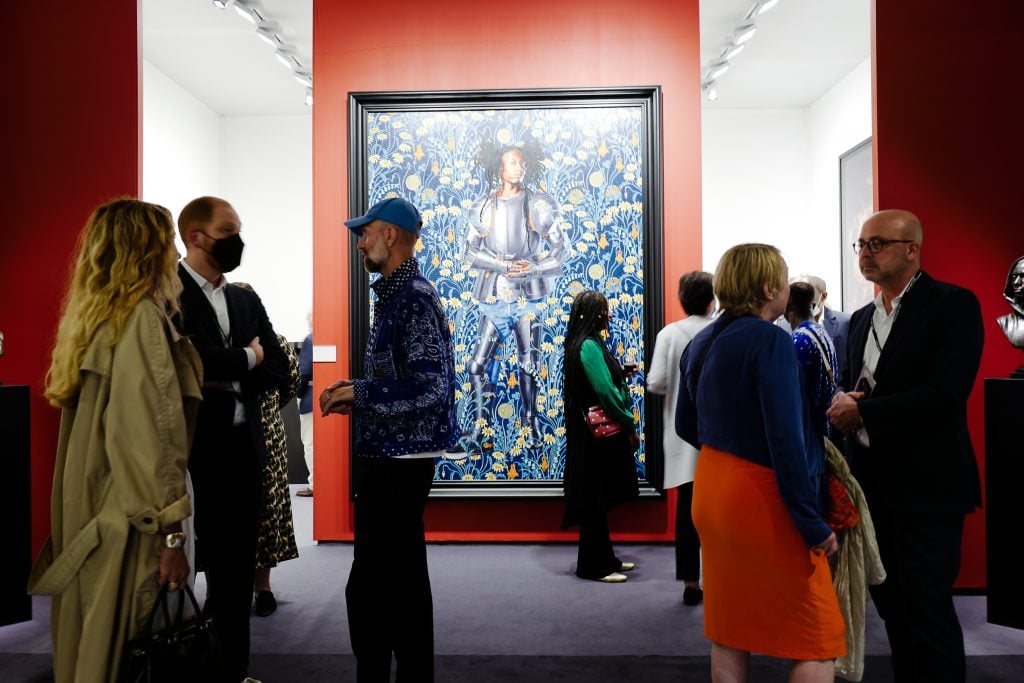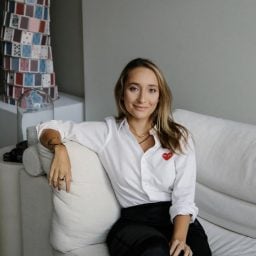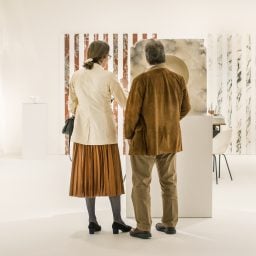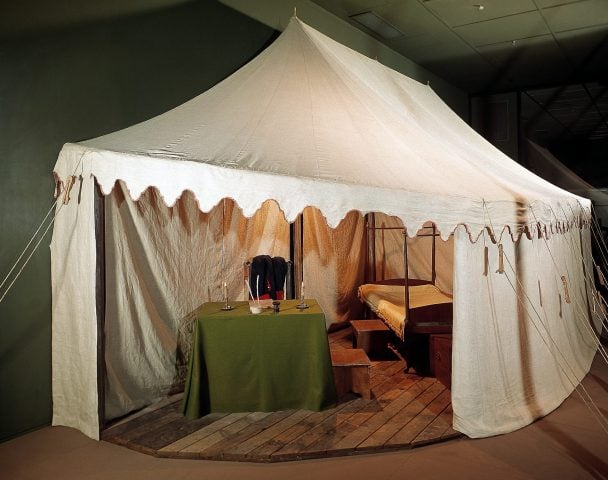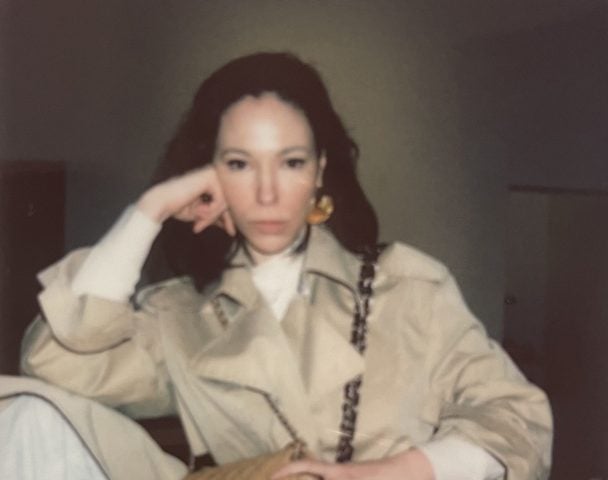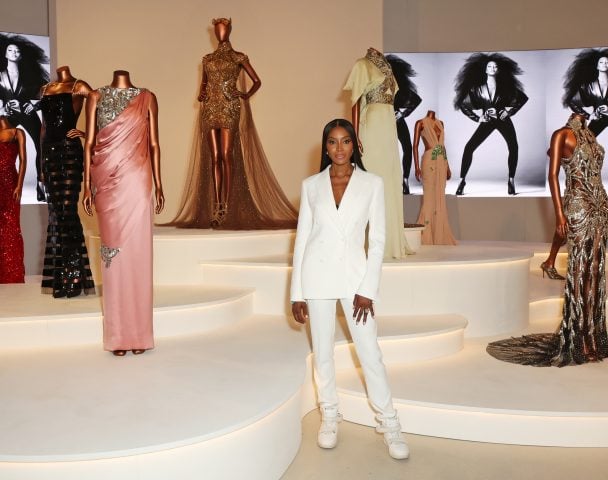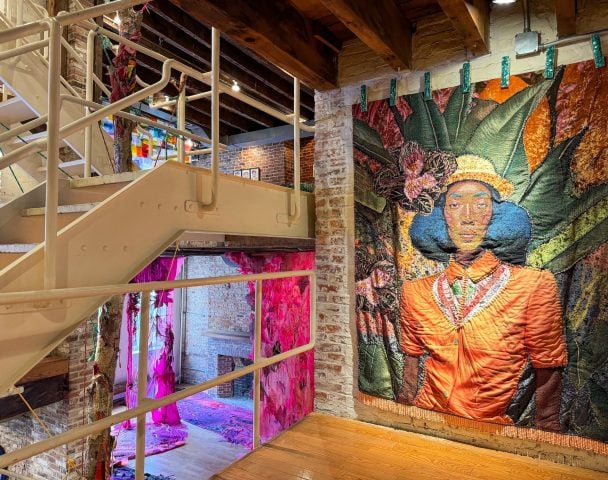The oysters came out in full force to mark the opening of TEFAF New York, the fair’s fifth event in the city since branching out beyond Maastricht in 2016. So, too, were scores of buyers snaking through the swanky booths at the Park Avenue Armory.
Vibes were positive, and understandably so: There’s a lot of good art, as well as furniture, jewelry, and antiques, on view.
Just being there, it seemed, was cause for celebration. Coming off two straight pandemic-related cancellations, this year marks the first in-person American edition of TEFAF since 2019. Ninety-one galleries the world over showed up for the fair, 13 of them for the first time.
Below is a selection of standouts from their booths, all sorted according to the number of zeros on the price tag.
Self Portrait with Palette (1917)
Marc Chagall
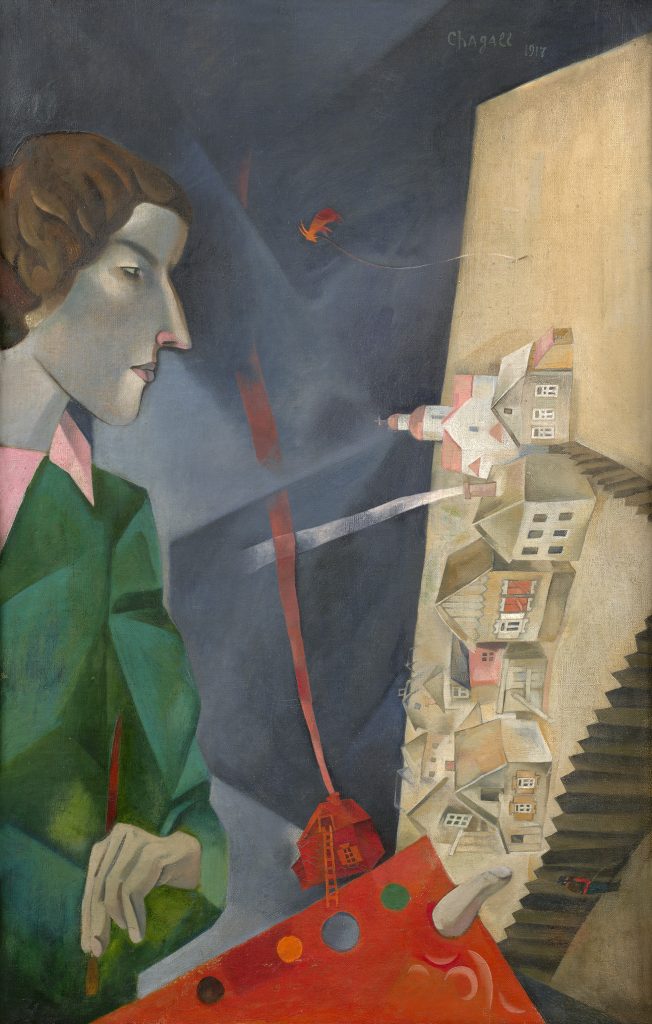
Marc Chagall, Self Portrait with Palette (1917). Courtesy of David Tunick, Inc.
Booth: David Tunick, Inc.
What It Costs: “Eight figures”
Why It’s Special: Stand in the booth of New York dealer David Tunick and you might forget that you are at a frenzied fair and not a quiet European museum. On view are prints by Munch and Picasso and paintings by Léger and Frankenthaler, but the real standout—perhaps of the entire fair—is a 1917 self-portrait by Marc Chagall. It depicts the artist standing before a canvas, painted on which is his home in the Russian ghetto of Vitebsk, which is today part of Belarus.
The artist completed the piece upon returning from Paris to his home in Russia, where he was stranded during the first World War. “It’s from 1917, which is really important—the year of the Russian Revolution,” Tunick said.
The dealer has been studying the painting for eight years, he said, researching its provenance, commissioning forensic tests, and even communing with the artist’s heirs. Tunick played coy about how much the artwork was going for, saying only that its price tag was “well into eight figures.”
—Taylor Dafoe
Portrait of Jorge Gitoo Wright (2022)
Kehinde Wiley
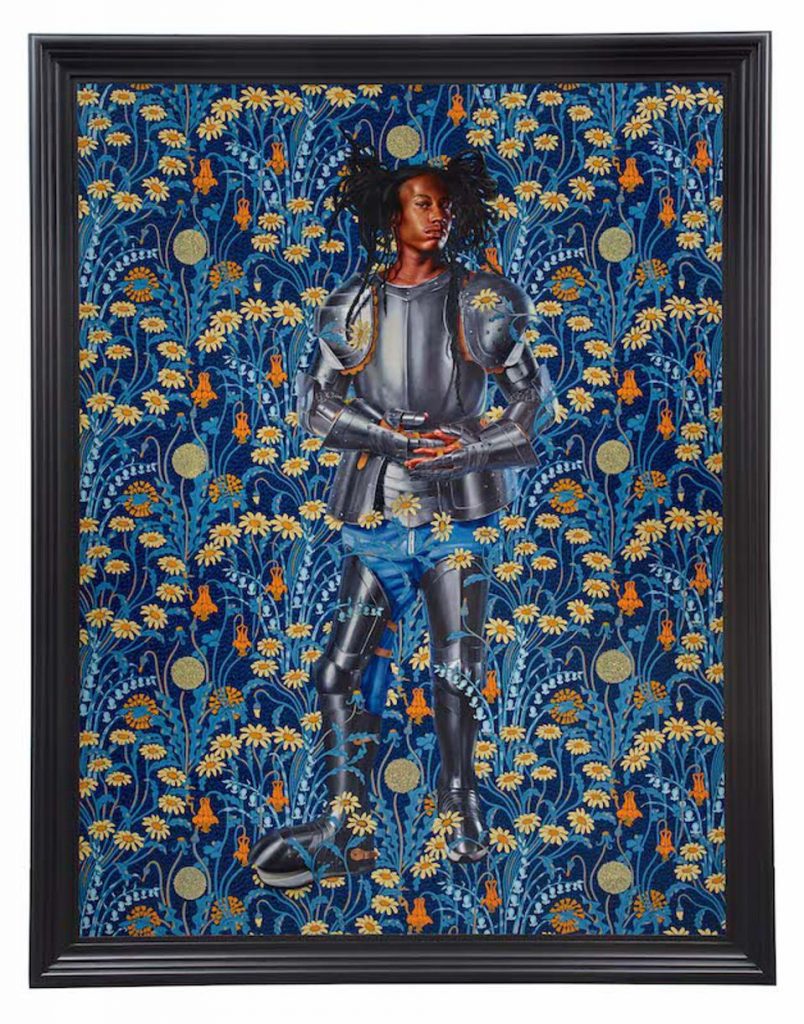
Kehinde Wiley, Portrait of Jorge Gitoo Wright (2022). Courtesy of Sean Kelly.
Booth: Sean Kelly
What It Costs: $750,000
Why It’s Special: It’s hard to miss Kehinde Wiley’s portrait of stylist and influencer Jorge Gitoo Wright, an eight-foot-tall painting installed on a frontward facing wall in Sean Kelly’s booth. Made specifically for the fair—and flanked on either side by two bronze busts, also made by Wiley—the painting recalls some of the more traditional European styles of portraiture you may associate with TEFAF, depicting Wright in a knight’s armor suit, cooly contrapposto.
The armor, Kelly explained, is a motif at the center of a new body of work for Wiley. “There are a lot of metaphors one could ascribe to it, but I think [it has to do with] how we present ourselves to the world and protects ourselves from it—this kind of carapace that we all, in some way, have to wear,” the gallerist said. “But you would never have seen a young Black man in armor, which was always custom-made and so expensive.”
Other pieces on view in Kelly’s booth include photographs by Marina Abramović and Candida Höfer, sculptures by Antony Gormley and Yves Klein, and a Monet-referencing painting by Laurent Grasso.
—Taylor Dafoe
Meine Großmutter (1924)
Lotte Laserstein
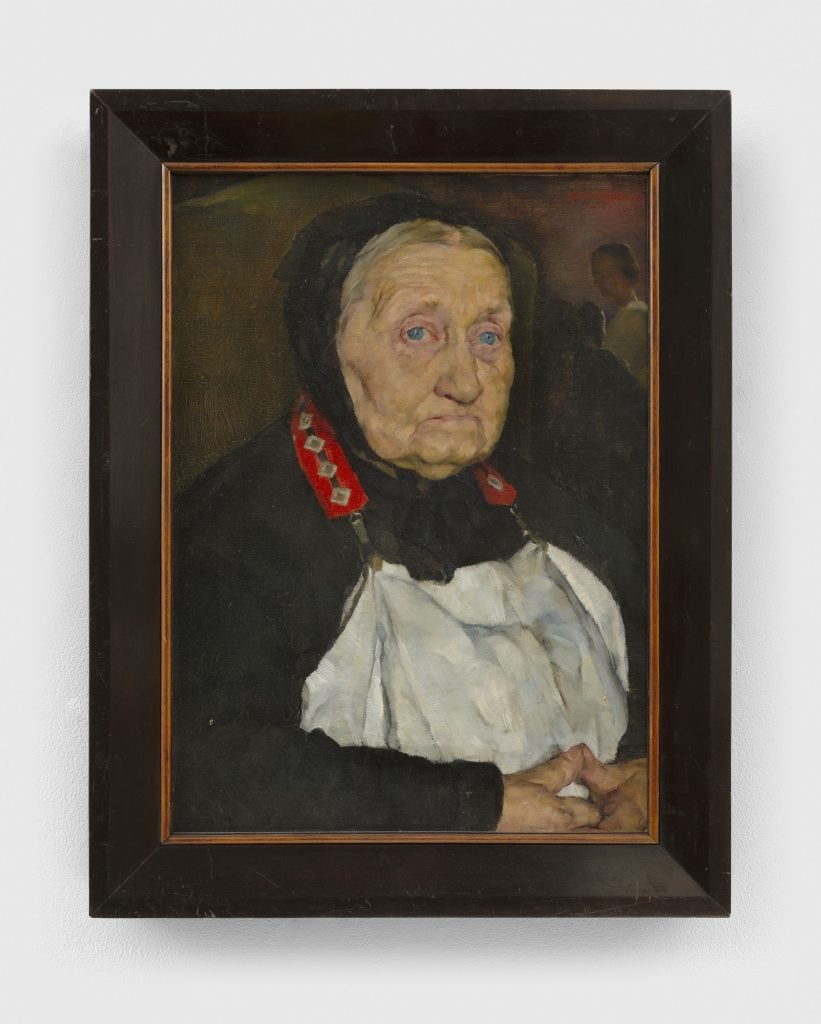
Lotte Laserstein, Meine Großmutter (1924). Courtesy of David Zwirner.
Booth: David Zwirner, New York
What It Costs: $200,000
Why It’s Special: Last fall, David Zwirner mounted an exhibition of works owned by Mickey Cartin, a veteran, Connecticut-based collector whose wares range from the historic (Dürer, Rembrandt) to the contemporary (Joe Coleman, Tom Sachs). “It’s an anti-art advisor kind of collection,” said Zwirner partner David Leiber at TEFAF, where the gallery is re-presenting a selection of highlights from the show. Cartin, he explained, is a collector who “likes to connect work from different cultures, different periods, doesn’t artificially limit himself.”
On view at the blue chipper’s booth are pieces by Josef Albers, Bill Traylor, and Martin Ramirez, but the stand-out among the bunch is a quiet portrait of an elderly woman Lotte Laserstein, a German-Jewish painter who settled in Sweden after being forced from her home country during World War II. Laserstein favored powerful female subjects throughout her career, and this particular painting, a portrait of the artist’s grandmother, is no different. But in it is an easter egg, too: “I’m not saying it’s a self-portrait, but that’s the artist right there in the top right corner,” Leiber said, pointing to a woman in the artwork’s blurred-out background.
—Taylor Dafoe
Night Vision (Neon) 2 (2022)
Teresita Fernández
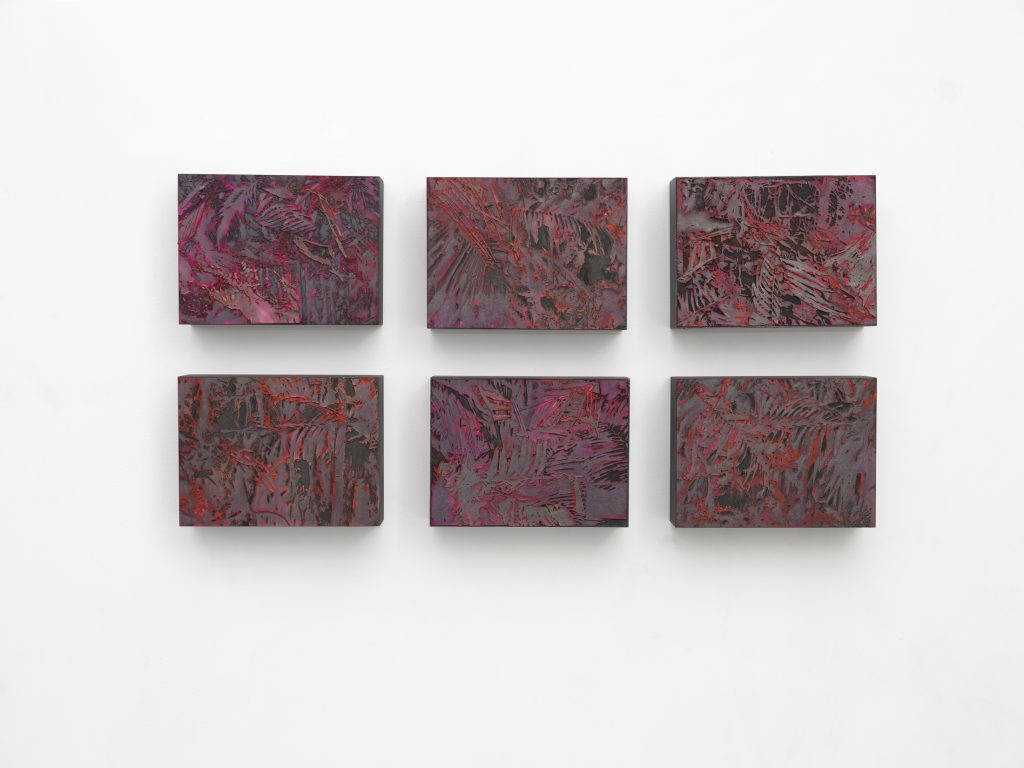
Teresita Fernández, Night Vision(Neon) 2 (2022). Courtesy of the artist and Lehmann Maupin, New York, Hong Kong, Seoul, and London.
Booth: Lehmann Maupin
What It Costs: $175,000
Why It’s Special: Four new, interconnected bodies of work from Teresita Fernández comprise Lehmann Maupin’s booth, each a rumination on landscape and our extractive relationship to it.
In the six pieces that make up Night Vision (Neon) 2, for instance, the artist layers tree-shaped pieces of paper atop wood panels, an effect that recalls dense Caribbean forestscapes. But just as quickly as Fernández’s collages coalesce into familiar images, they blur into abstraction, stripped of their complexion. “I’m interested in the idea that you are an extension of the landscape, that you are a part of it and it is a part of you,” Fernández explained in a statement. “The landscape is never passive. You look at the landscape, but it also looks back at you.”
“Fernández’s powerful work reminds us about the complicated history that the Caribbean has been enduring to this day,” said Lehmann Maupin director Alva Stux. “At TEFAF we are presenting it as an immersive installation, where viewers and collectors are invited to engage with the work in a meditative way, bringing us closer to these complicated topics and opening up a space for contemplation, discussion, and learning.”
—Taylor Dafoe
The Gentlewoman of the Aggravation of our Incoherences (2022)
Anh Duong
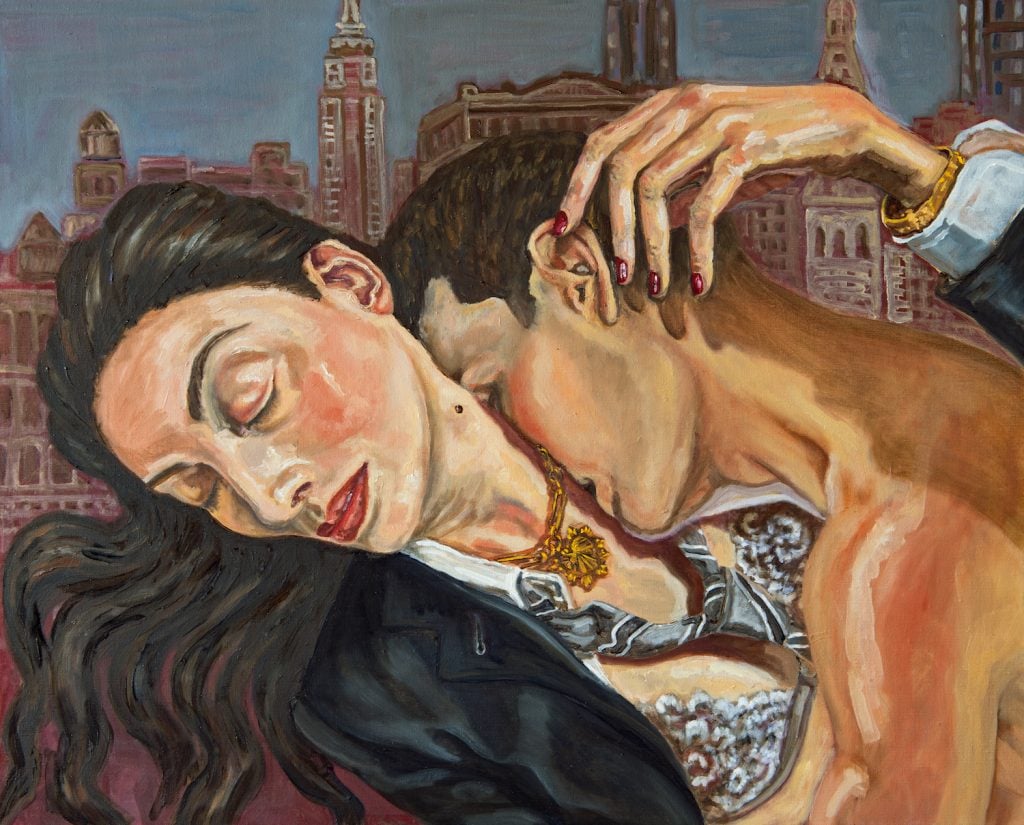
Anh Duong, The Gentlewoman of the Aggravation of our Incoherences (2022). Courtesy of Galerie Gmurzynska.
Booth: Galerie Gmurzynska, New York, Zurich, and Zug
What It Costs: $60,000
Why It’s Special: After moving to New York from her native France in 1988, Anh Duong, who is of Vietnamese and Spanish parentage, began working as a fashion model, and soon she was posing for famous photographers, summering at Andy Warhol’s Montauk beach house, and dating Julian Schnabel.
But in addition to her success in modeling and acting, Duong has also shown her paintings since the early 1990s with dealers including Sonnabend Gallery and Sperone Westwater in New York, and Robilant and Voena in London.
“She’s been a muse to so many, but through her painting she reclaims her own image,” the gallery’s Lucas Bsher told Artnet News.
When she dropped off her newest work for TEFAF, Duong joked that the oil paint was still wet. The self-portrait, of an intimate embrace, is part of a new body of work that is also on view in a solo show hosted by the gallery at Spring Place in Los Angeles (on view through September 1).
“I think this is really her time,” Isabelle Bscher added, noting that the gallery is waiting to announce an upcoming museum show for Duong. “She’s had an interesting career in movies and fashion and art, and the only place to go is up.”
—Sarah Cascone

Dorothea Tanning, Maternity (1977). Photo courtesy of Kasmin Gallery, New York, ©2022 the Destina Foundation/Artists Rights Society (ARS), New York.
Booth: Kasmin, New York
What It Costs: $22,000
Why It’s Special: Working with the artist’s foundation, Kasmin recently staged Dorothea Tanning’s first major New York outing in decades, illuminating her work beyond the Surrealist masterpieces for which she is best work. The foundation also offered up a pair of small, surprisingly affordable oil pastel drawings that didn’t make it into the exhibition, but are instead on offer at the fair. (The other, Pastel Quiet, has never been publicly exhibited before and is priced at $24,000.)
Maternity, which appeared in Tanning’s retrospective at the Tate Modern in London, was made relatively late in the artist’s 70-year career. “In the 1930s and ’40s, she did this hyperrealist Surrealist painting, but then she turned to gestural abstraction,” Kasmin senior director Eric Gleason told Artnet News. “Here, elements of figuration are coming back into the work in these abstracted, anthropomorphic forms.”
—Sarah Cascone
A Hawthorn and Tampopo Bud Bowl (2021)
Hitomi Hosono

Hitomi Hosono, A Hawthorn and Tampopo Bud Bowl (2021). Photo courtesy of Adrian Sasoon, London.
Booth: Adrian Sassoon, London
What It Costs: $12,500
Why It’s Special: Japanese-born, London-based ceramicist Hitomi Hosono painstakingly sculpts lush, floral-inspired porcelain bowls and vases, which can be found in the collection of the British Museum.
“She just creates these exquisite, lace-like pieces,” Olivia Bridges of Adrian Sassoon gallery told Artnet News. “She throws a plain vessel and then she hand molds and carves each individual leaf, layering as she goes. There’s this fantastic build up of decoration.”
—Sarah Cascone
Follow Artnet News on Facebook:
Want to stay ahead of the art world? Subscribe to our newsletter to get the breaking news, eye-opening interviews, and incisive critical takes that drive the conversation forward.
